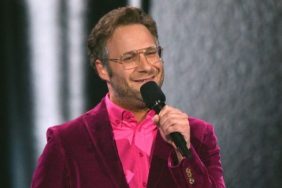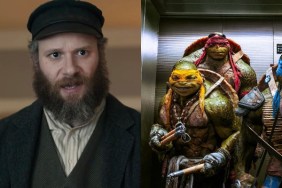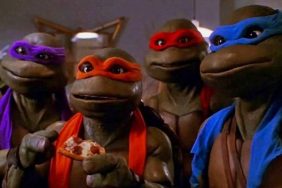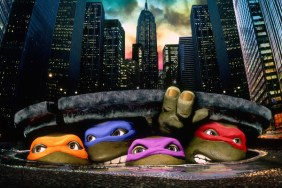The new Teenage Mutant Ninja Turtles movie has been under very close scrutiny from fans of the franchise since day one. Whether the changes to the Turtles’ designs and origins were brilliant ideas or terrible is up to the fans, but before you judge, put yourself in the filmmakers’ position. Imagine you were handed the reins of a beloved property and given the responsibility to retell their origin in a new way, using new technology. What decisions would you make, and why?
That’s what I wanted to know when I got in a room with Teenage Mutant Ninja Turtles director Jonathan Liebesman and his producers Andrew Form and Brad Fuller. We went into detail about the film’s biggest action sequence, a car chase down a mountainside in the snow, and why the film goes into more detail about the heroes’ origins than ever before and made certain changes along the way. And of course we talked about Shredder Plus – their name for the Shredder’s exo-skeleton in the new movie – and they teased their (thus far) unused plans for a “Super-Duper Shredder” too.
Teenage Mutant Ninja Turtles opens in theaters on August 8, 2014.
Related: ‘Teenage Mutant Ninja Turtles’ Review: Extra Cheese
CraveOnline: Gentlemen, it’s been a long strange trip.
Andrew Form: Yes. Very.
Jonathan Liebesman: Years.
So when you got the rights to these movies, was this the movie you envisioned or did it go through a lot of changes?
Andrew Form: Well, you know, Viacom bought the rights and we begged for this job. We have an overall deal at Paramount and Michael [Bay] directs all the Transformers movies there, so in a long-winded answer, yes.
This is the one?
Andrew Form: This is the one. The hardest thing with the movie for us was always the tone, and finding that tone, and this is what we all hoped for. Yeah.
Tell me about finding this guy [Jonathan Liebesman].
Andrew Form: This guy… Well, we made a movie with this guy a long time ago. He’s been a very close friend of ours for eight, nine years now, and it’s actually a very funny story. So Jonathan Liebesman was directing Wrath of the Titans, he was over in London, and we tried to get a meeting with him, get him on the phone to talk about Ninja Turtles and he was so deep in post that even being a buddy, we couldn’t get him on the phone. And I totally get it, we know what it’s like. He’s finishing this huge movie. But we had heard that he was in town for one day to show his movie to Warner Bros., he had flown in from London, and Brad and I literally crashed into his his house, rang the bell, he opened the door, it was us. He had no idea we were coming…
Was he clothed?
Jonathan Liebesman: Barely!
Brad Fuller: He might have been in a towel.
Jonathan Liebesman: I was clothed. One of the few times…
Andrew Form: We were developing a script and we wanted him to direct it, and we had had a pre-vis artist do a very rough version of the snow chase scene. It was in the early script. And we said, “We know you’re crazy [busy], we know you’re showing a movie, blah-blah-blah, but just put this on your TV and watch it and then we’ll leave! We’ll hug, and nice to see you, haven’t seen you in two years because you’re off making the movie.” So we showed him the snow chase and said, “If you like this pre-vis, please read our script on your plane ride back to London, let’s talk in a day or two.” And here are, two and a half years later, and that’s how we made it happen with him for our second movie [together].
Was that sequence changed over time? Were you like, “Let me tell you what’s wrong with the snow sequence?”
Andrew Form: Yeah, that’s it. Everyone has to.
Jonathan Liebesman: Obviously the sequence changed over time but there were some fundamental things that are still a part of it today, such as the luging on the shells, and there was one particular moment where, for me, a turtle slid under the truck that was awesome…
That was awesome.
Jonathan Liebesman: And there was that signature moment where the Turtle somersaults into the Humvee…
Andrew Form: But you know what? Just to cut him off? What he was able to do that was not done in the pre-vis…? It was just an action scene. Action-for-action. And he was actually able to put the character moments into that scene. Because I think if it was just action-for-action it will get boring. Because you get these amazing moments where Donatello flips a car and then you’re top of him and he’s smiling and having the time of his life? That was never in the pre-vis. You can’t pre-vis that. That’s stuff that the director brings into the movie. There’s five or six of those moments that break up the action and you have these great character beats. I think that’s one of the big things that Jonathan adds to that sequence.
Jonatha Liebesman: I think what we wanted to do was be very ambitious with the shots. You know, there’s these long, flowing shots that ILM was able to pull off for us. But there was fundamentally something really new in that initial pre-vis that I had never seen.
What was that?
Jonathan Liebesman: Seeing Turtles luging and doing things that I had never seen them do in the cartoon. The technology that I had seen in Planet of the Apes, in my head, I was like… because you had Michael Bay’s name. If there was a way to get the technology, to use the latest technology to bring that to life, it would be incredible. And I have to say, when I look back two and a half years ago and see what the snow chase became, that is exactly what we hoped it would be.
Brad Fuller: But tonally there was…
Andrew Form: There were so many great moments in the snow chase for me, where Michelangelo had those great lines, that came out of you shooting this movie, that were never in the pre-vis.
Brad Fuller: Right.
Andrew Form: There was no dialogue in the pre-vis. It was an action.
Jonathan Liebesman: And I also have to say we had an amazing team around us. Great writers who helped throw out lines. It was fantastic being on a motion-capture stage where you have these four actors luging on their backs, and writers throwing out lines like, “Say this! Try this! Try that!” And that’s where you get lines like on the rooftop, like, “Step into the Wu-Tang!” None of us would have ever thought of that.
None of you are Wu-Tang fans?
Andrew Form: All of us are Wu-Tang fans, we just didn’t know if it would go into the Turtles movie.
Jonathan Liebesman: Or the Batman line. There’s just so much stuff that comes from the team of people.
It’s a perpendicular segue, but I’d like you to tell me about the way this film was developed, and the origin of the Turtles. It seems like this wouldn’t be the version of the film you would have made ten years ago, before Batman Begins looked at origin of heroes and felt the need to explain it all. Where did they learn ninjitsu? Where did they get the weapons… actually, I don’t think you mention where they got the weapons…
Andrew Form: Well, Splinter gives them their weapons.
He just had them.
Andrew Form: Yes.
Okay, but tell me about the development of that. Why was it important to show that April was always connected to the Turtles, for example?
Jonathan Liebesman: For me, I love the reasons for everything. When I watch a well thought-out movie, whether it’s the way Jim Cameron expands on his Terminator universe from Terminator 1 to Terminator 2, and you start learning about why there were things in Terminator 1 from Terminator 2… I love that sort of deconstruction of the superhero, and I think that’s what we appreciate from Chris Nolan’s thing. And I’m always fighting for more of that. It can be very boring for people who aren’t Ninja Turtles fans though.
You even joke in the film about how absurd this whole thing is for people on the outside looking in, just because the concept is ridiculous.
Jonathan Liebesman: Right.
Was there every a point where you thought, we don’t need to explain it? It’s Teenage Mutant Ninja Turtles. We’re already really stretching disbelief.
Jonathan Liebesman: Absolutely, but like I said, the fun for me is – even if it is absurd, and a parody on superheroes – to pretend it isn’t. And the audience knows you’re just pretending and that’s what makes it funny. I love the reasons for everything. Listen, if it was up to me I’d have like an hour of origin story, but I just don’t think that’s… Listen, we battled for the same thing in the Texas Chainsaw prequel. There was the argument of how much time you spend watching Leatherface become Leatherface.
Andrew Form: And do you love him or hate him the more you get to know him? And I think in this case you love those Turtles more whether you know the history or not, seeing them grow up.
Brad Fuller: We also wanted to make a movie that, if you hadn’t read the comics, seen the cartoons or the 90s movies, you could enjoy this movie.
Jonathan Liebesman: That’s 100% true and that’s why for me I was always erring on the side of, “I want more.” But the truth is what Brad is saying and what Drew is saying is right, because it’s really all about the relationships between the Turtles, and if you love them and the way they are to each other, you’ll go on the journey with them.
It’s a very briskly paced movie though. We get the characters, and they’re always interacting, and hopefully we get to know them but the movie has to move from plot point to plot point. What is it, about 90 minutes?
Brad Fuller: Ninety-six.
It’s a brisk movie by modern blockbuster standards. Is there a longer version with a lot more character development that’s on the cutting room floor?
Jonathan Liebesman: Listen, we did shoot a lot. I think the challenge with this movie, you see a big budget movie usually the action is super expensive because that’s where your CGI is. In this movie, the dialogue is where the movie’s expensive. So we had to tell a story within an amount of time that was within our budget, and also pick and choose which were the most important scenes. So there was always scenes which were on the cutting room floor. Like I said, I was try to fit in some origin stuff here or do some stuff there, but ultimately what’s most important is in the movie.
If you had shot anything else, would it be too expensive to ever finish it and put it on a DVD?
Jonathan Liebesman: Yeah, you can’t do that. Each shot literally costs like $50,000. You can’t have, “Oh, let’s have this deleted scene three minutes of Turtles talking.” That’s like a million and a half, two million dollars, you know?
Tell me about the redesign of The Shredder. It seems we’ve moved on straight to Super Shredder in this one.
Jonathan Liebesman: Oh, we actually… remember Super Shredder, buddy?
Andrew Form: We actually had a Super Shredder.
Jonathan Liebesman: We had a Super-Duper Shredder.
Andrew Form: It was nuts, the Super Shredder.
Brad Fuller: This is Shredder Plus.
Jonathan Liebesman: This is like Shredder Plus, you’re right. […] We can’t tell you about Super-Duper Shredder…
Sequel!
Jonathan Liebesman: No, fuck, I hope people go and watch the movie and you guys rehire me and then we can talk about a sequel. But what was the question?
Tell me about the supersuit, because it used to just be that Shredder was such a great fighter that that was enough of a challenge alone. Now the Turtles have super-strenght, so you gave him a super suit.
Jonathan Liebesman: I think what happens is if you’re going to buff up the Turtles, like we did, you need the villain to be physically… You don’t ever want you villain to be an underdog. If he’s going to take on four buff, awesome Turtles he has to look the part.
Let’s go back further. Why did you feel the need to buff up the Turtles? They’re taller than they’ve ever been…
Jonathan Liebesman: So Michael [Bay]s’ initial instinct, which I think is an excellent instinct, is for people who aren’t fans of the Turtles, he wanted to distinguish them physically from one another so you could literally see their silhouette and tell the difference between the Turtles. And I think that’s very smart because not everyone grew up loving Ninja Turtles.
Philistines.
Andrew Form: Right, all of them.
Jonathan Liebesman: We agree. And so what Mike also wanted was to make them bigger, to make them buffer, and I have to tell you – and I can’t remember if I’ve said this – but I had the opportunity when I was directing Texas Chainsaw Massacre to watch how he took an 80s property in Transformers and reinvented it. I saw the behind the scenes of Transformers and thought when he took the movie, I was like, “What is he doing? That’s so dumb what he’s going to do.” And then I saw the pre-vis of what he was going to actually realize and I thought it was actually incredible. So I really trusted his instincts on this, and I think when you see the movie any hesitation fans have goes away very quickly, because what’s really important is not the way the Turtles look. That’s important to believe that they’re really in the world you live in, but what’s more important is the essence of the Turtles and staying true to the charm and the fun of the cartoons and the movies that we fell in love with, and the comic books that Eastman and Laird wrote. So my point is, having fully trusted Bay, and believing that the Turtles should look like they do, naturally you come the conclusion that Shredder needs to look the part of something able to kill these Turtles easily. An action movie’s only as good as the bad guy.
William Bibbiani is the editor of CraveOnline’s Film Channel and the host of The B-Movies Podcast and The Blue Movies Podcast. Follow him on Twitter at @WilliamBibbiani.









